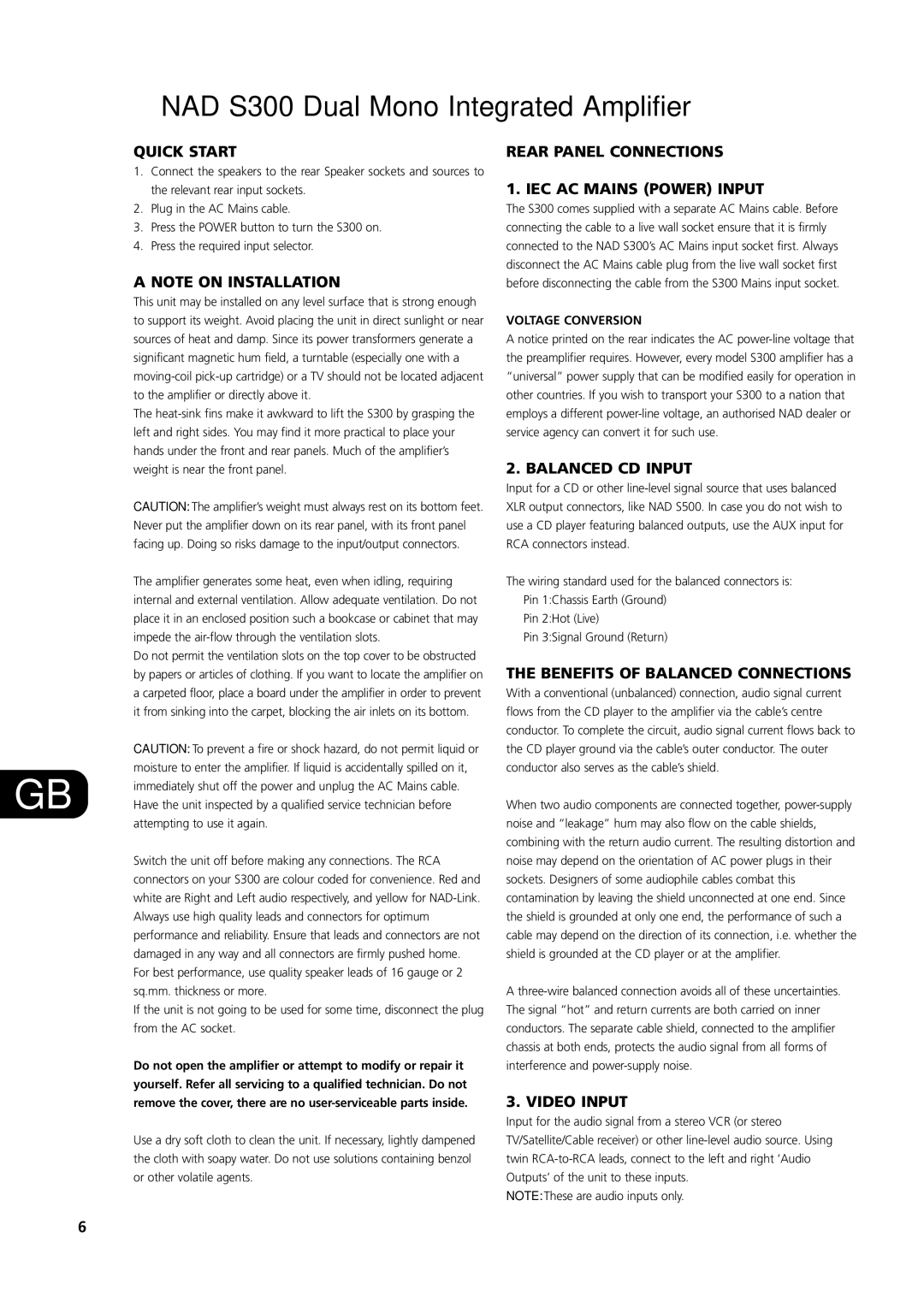QUICK START
1.Connect the speakers to the rear Speaker sockets and sources to the relevant rear input sockets.
2.Plug in the AC Mains cable.
3.Press the POWER button to turn the S300 on.
4.Press the required input selector.
A NOTE ON INSTALLATION
This unit may be installed on any level surface that is strong enough to support its weight. Avoid placing the unit in direct sunlight or near sources of heat and damp. Since its power transformers generate a significant magnetic hum field, a turntable (especially one with a moving-coil pick-up cartridge) or a TV should not be located adjacent to the amplifier or directly above it.
The heat-sink fins make it awkward to lift the S300 by grasping the left and right sides. You may find it more practical to place your hands under the front and rear panels. Much of the amplifier’s weight is near the front panel.
CAUTION: The amplifier’s weight must always rest on its bottom feet. Never put the amplifier down on its rear panel, with its front panel facing up. Doing so risks damage to the input/output connectors.
The amplifier generates some heat, even when idling, requiring internal and external ventilation. Allow adequate ventilation. Do not place it in an enclosed position such a bookcase or cabinet that may impede the air-flow through the ventilation slots.
Do not permit the ventilation slots on the top cover to be obstructed by papers or articles of clothing. If you want to locate the amplifier on a carpeted floor, place a board under the amplifier in order to prevent it from sinking into the carpet, blocking the air inlets on its bottom.
CAUTION: To prevent a fire or shock hazard, do not permit liquid or moisture to enter the amplifier. If liquid is accidentally spilled on it,
GB immediately shut off the power and unplug the AC Mains cable. Have the unit inspected by a qualified service technician before attempting to use it again.
Switch the unit off before making any connections. The RCA connectors on your S300 are colour coded for convenience. Red and white are Right and Left audio respectively, and yellow for NAD-Link. Always use high quality leads and connectors for optimum performance and reliability. Ensure that leads and connectors are not damaged in any way and all connectors are firmly pushed home. For best performance, use quality speaker leads of 16 gauge or 2 sq.mm. thickness or more.
If the unit is not going to be used for some time, disconnect the plug from the AC socket.
Do not open the amplifier or attempt to modify or repair it yourself. Refer all servicing to a qualified technician. Do not remove the cover, there are no user-serviceable parts inside.
Use a dry soft cloth to clean the unit. If necessary, lightly dampened the cloth with soapy water. Do not use solutions containing benzol or other volatile agents.
REAR PANEL CONNECTIONS
1. IEC AC MAINS (POWER) INPUT
The S300 comes supplied with a separate AC Mains cable. Before connecting the cable to a live wall socket ensure that it is firmly connected to the NAD S300’s AC Mains input socket first. Always disconnect the AC Mains cable plug from the live wall socket first before disconnecting the cable from the S300 Mains input socket.
VOLTAGE CONVERSION
A notice printed on the rear indicates the AC power-line voltage that the preamplifier requires. However, every model S300 amplifier has a “universal” power supply that can be modified easily for operation in other countries. If you wish to transport your S300 to a nation that employs a different power-line voltage, an authorised NAD dealer or service agency can convert it for such use.
2. BALANCED CD INPUT
Input for a CD or other line-level signal source that uses balanced XLR output connectors, like NAD S500. In case you do not wish to use a CD player featuring balanced outputs, use the AUX input for RCA connectors instead.
The wiring standard used for the balanced connectors is: Pin 1:Chassis Earth (Ground)
Pin 2:Hot (Live)
Pin 3:Signal Ground (Return)
THE BENEFITS OF BALANCED CONNECTIONS
With a conventional (unbalanced) connection, audio signal current flows from the CD player to the amplifier via the cable’s centre conductor. To complete the circuit, audio signal current flows back to the CD player ground via the cable’s outer conductor. The outer conductor also serves as the cable’s shield.
When two audio components are connected together, power-supply noise and “leakage” hum may also flow on the cable shields, combining with the return audio current. The resulting distortion and noise may depend on the orientation of AC power plugs in their sockets. Designers of some audiophile cables combat this contamination by leaving the shield unconnected at one end. Since the shield is grounded at only one end, the performance of such a cable may depend on the direction of its connection, i.e. whether the shield is grounded at the CD player or at the amplifier.
A three-wire balanced connection avoids all of these uncertainties. The signal “hot” and return currents are both carried on inner conductors. The separate cable shield, connected to the amplifier chassis at both ends, protects the audio signal from all forms of interference and power-supply noise.
3. VIDEO INPUT
Input for the audio signal from a stereo VCR (or stereo TV/Satellite/Cable receiver) or other line-level audio source. Using twin RCA-to-RCA leads, connect to the left and right ‘Audio Outputs’ of the unit to these inputs.
NOTE: These are audio inputs only.

